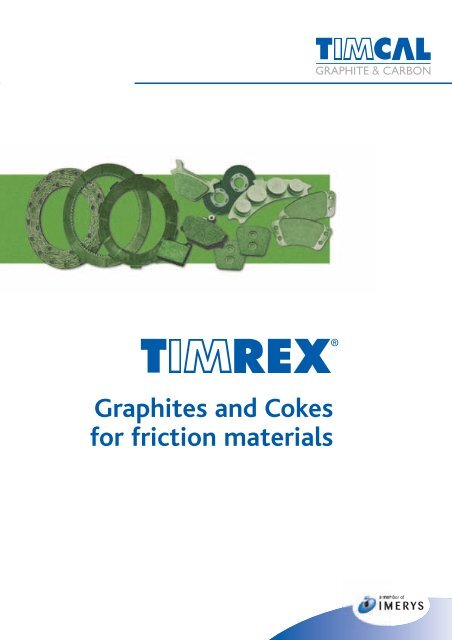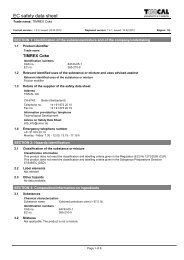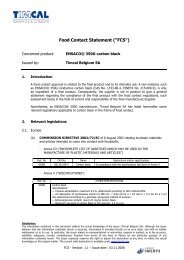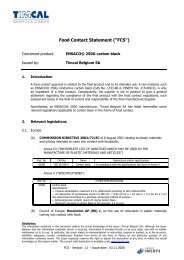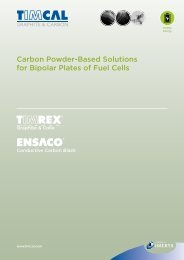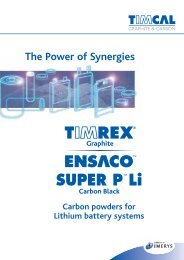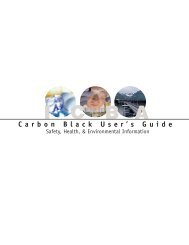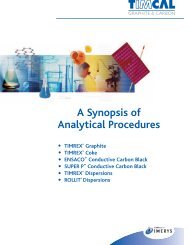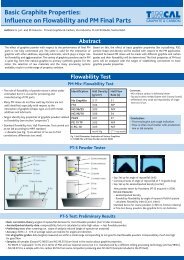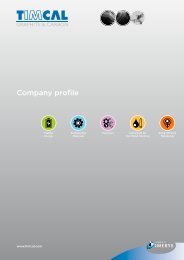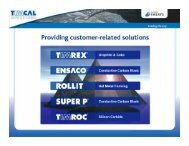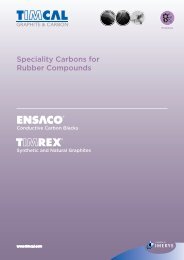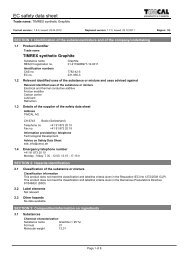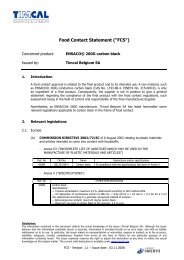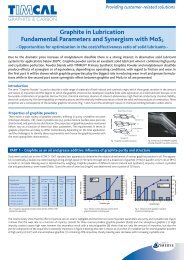TIMREX® Graphites and Cokes for Friction Materials - Timcal
TIMREX® Graphites and Cokes for Friction Materials - Timcal
TIMREX® Graphites and Cokes for Friction Materials - Timcal
You also want an ePaper? Increase the reach of your titles
YUMPU automatically turns print PDFs into web optimized ePapers that Google loves.
<strong>Graphites</strong> <strong>and</strong> <strong>Cokes</strong><strong>for</strong> friction materials
www.timcal.comWho are we?About frictionmaterialsTIMCAL Group has a strong tradition<strong>and</strong> history in graphite manufacturing. Itsfirst manufacturing operation was foundedin 1908. Today, TIMCAL Group facilitiesproduce <strong>and</strong> market a large variety of synthetic<strong>and</strong> natural graphite powders <strong>and</strong>dispersions of consistent high quality.Adhering to a philosophy of Total QualityManagement <strong>and</strong> continuous processimprovement, all TIMCAL manufacturingplants comply with ISO 9001-2000.TIMCAL is committed to produce highlyspecialized graphite <strong>and</strong> carbon materials<strong>for</strong> today’s <strong>and</strong> tomorrow’s friction materialsindustries.TIMCAL has an international presencewith facilities <strong>and</strong> commercial officeslocated in the key markets around theGlobe. The Group’s industrial <strong>and</strong> commercialactivities are implemented by an experiencedmulti-national team of nearly 300employees from seven countries on threecontinents.TIMCAL Group is a member ofIMERYS, a world leader in adding value tominerals.TIMREX ® <strong>Graphites</strong> combine technical<strong>and</strong> economic advantages: their optimalprice/per<strong>for</strong>mance ratio helps maintaing ahigh quality level in the finished part while, atthe same time, reducing manufacturing costs.Bodio, Switzerl<strong>and</strong>Willebroek, BelgiumLac des Îles, CanadaRapid developments over the past fewyears within the automotive industry haveresulted in a growing dem<strong>and</strong> <strong>for</strong> high-qualityfriction materials.The main requirement to be met by abrake lining is, besides a high level of energyabsorption, a high brake efficiency within awide temperature range. Com<strong>for</strong>t aspects,life-time, <strong>and</strong> absence of noise are factorswhich also dem<strong>and</strong> important consideration.These requirements are fulfilled by meansof high per<strong>for</strong>mace brake pads in which carbonpowders such as graphite <strong>and</strong> coke playa key role.The extreme consistency of TIMREX ®Carbons provides the predictable propertiesthat makes development <strong>and</strong> productionvery efficient.This documentation is intended to helpour customers make the best possible selectionfrom the wide range of TIMREX ®Graphite <strong>and</strong> Coke materials available <strong>for</strong>use in their high per<strong>for</strong>mance friction applications.Terrebonne, CanadaChangzhou, ChinaFuji, Japan
Graphite <strong>and</strong>Coke Powders<strong>for</strong> Brake Linings<strong>and</strong> ClutchFacingsThe MarketBrake Linings <strong>and</strong> Brake PadsNon- metallic organic brake pads (NAO)Resin-bonded metallic pads (semimetallic)Low-metallic organic brake padsSintermetallic materials <strong>for</strong> aircrafts,high speed trains, heavy duty machinesCFC- <strong>and</strong> C/C-materials as well as brake pads<strong>for</strong> C/C-brake discs(CFC: Carbon fiber composites; C/C: Carbon composites)Linings <strong>for</strong> drum brakesOrganic brake pads <strong>for</strong> trainsClutch Facings<strong>for</strong> Dry <strong>and</strong> Wet ApplicationsSintered metallic clutch facingsOrganic-bonded paper- <strong>and</strong> fiberclutch facingsTIMREX ® <strong>Graphites</strong><strong>and</strong> <strong>Cokes</strong> witha common keyword:consistencyTIMREX ®Primary Synthetic GraphiteTIMREX ® Primary Synthetic <strong>Graphites</strong>are produced in a unique highly controlledgraphitization process wichassures narrow specifications <strong>and</strong>unequalled consistent quality due to:monitoring of all production <strong>and</strong> processingstages, strict final inspection, <strong>and</strong>clearly defined development processes.TIMREX ® Primary Synthetic <strong>Graphites</strong>show unique properties thanks to thecombination of a consistent purity, perfectcrystalline structure <strong>and</strong> well definedtexture.TIMREX ®Natural Flake GraphiteTIMREX ® Natural Flake Graphite is producedin a wide range of products distinguishedby particle size distribution, chemistry<strong>and</strong> carbon content. <strong>Timcal</strong> mines thegraphite from its own source in Lac-des-Îles,Quebec, Canada. This unique “close-to-customer”location guarantees very fast <strong>and</strong>reliable deliveries.All TIMREX ® “Naturals” are thoroughlycontrolled in our laboratories to ensure quality,consistency <strong>and</strong> above all, total customersatisfaction.TIMREX ® CokeTIMREX ® Petroleum Coke is calcined atappropriate temperature with low ash <strong>and</strong>sulfur content, well defined texture <strong>and</strong> consistentparticle size distribution.
www.timcal.comTIMREX ®Carbons <strong>for</strong><strong>Friction</strong> <strong>Materials</strong>Typical valuesAsh(%)Moisture(%)CrystalliteheightLc (nm)Tapdensity(g/cm 3 )DBP absorbtion(Dibutylphthalate)(g/100g)T GraphiteT 750.070.1> 1000.21*103T 15-750.030.02> 1000.33*70T 1500.090.05> 1000.5159T150-6000.090.05> 1000.5923T 8000.080.05> 1000.6433T 200-20000.080.03> 1000.73210 500 1000 15002000Particle size range d (µm)* Scott densityKS GraphiteKS 750.070.1> 1000.24*98KS 5-75TT0.040.02> 1000.41*45KS 1500.060.05> 1000.6052KS 5000.060.04> 1000.8025KS 150-600SP0.060.04> 1000.7717KS 300-12500.060.04> 1000.72140 500 1000 1500Particle size range d (µm)* Scott density
Particle shapeAdvantages <strong>and</strong> applicationsangular flakes, microporousSuitable especially <strong>for</strong> organicbonded clutch facings (paper, fiber)<strong>and</strong> organic brake linings(semimetallic, non-metallic,low-metallic).Good lubrication propertiesReduction of the friction level <strong>and</strong> smoothingof the friction coefficientGood thermal conductivityReduction of hot spots <strong>and</strong> difference thickness vibration(DTV) by spring back <strong>and</strong> good thermal conductivityHigh effectivness of wear-reduction at relatively lowgraphite concentrationsGood damping behaviour due to internal lubricity<strong>and</strong> micropores - noise reductionGood wettability with organic binders <strong>and</strong> high adhesionstrength between binder <strong>and</strong> graphite particleirregular spheroidsSuitable especially <strong>for</strong> sinteredmetallic clutch facings <strong>and</strong>brake pads.Good lubrication propertiesGood transfer film <strong>for</strong>mationSmoothing of the friction coefficient at the required levelGood thermal conductivityReduction of hot spots <strong>and</strong> DTVGood mixability with metal powdersSufficient mechanical strength of sintered parts even atmedium density - no lamination
www.timcal.comTIMREX ®Carbons <strong>for</strong><strong>Friction</strong> <strong>Materials</strong>Typical valuesAsh(%)Moisture(%)CrystalliteheightLc (nm)Tapdensity(g/cm 3 )DBP absorbtion(Dibutylphthalate)(g/100g)Natural FlakeGraphiteGA 95/75-150 mesh FR< 5< 7< 0.5< 0.5> 350> 3500.520.659141-100 mesh FR< 7< 0.5> 3500.7542- 80 mesh FR< 7< 0.5> 3500.693780 x 150 mesh FR< 7< 0.5> 3500.741650 x 100 mesh FR< 7< 0.5> 3500.781150 x 80 mesh FR< 7< 0.5> 3500.82100 250 500 750 1000Particle size range d (µm)20 x 50 mesh FR< 7< 0.5> 3500.7710CokeFC 250FC 800FC 250-15000.070.070.070.020.020.02~2.5~2.5~2.50.911.000.906.06.05.60 500 1000 1500Particle size range d (µm)
Particle shapeAdvantages <strong>and</strong> applicationsflakesSuitable <strong>for</strong> all organic bondedfriction materials, especially <strong>for</strong>linings in drum brakes as well as inbrake pads <strong>for</strong> trains.Good transfer film <strong>for</strong>mationGood thermal conductivityExcellent lubricating propertiesirregularSuitable <strong>for</strong> all kind ofsintered <strong>and</strong> organic bondedfriction materials.Low wear of counterpart due to low ash contentStable friction coefficient, non-fadingHigh thermal stabilityReduction of noise, especially medium <strong>and</strong> highfrequency sounds
www.timcal.comPowderPropertiesGraphite <strong>and</strong> coke<strong>and</strong> their role in frictionmaterialsTIMCAL Group is in the position to provideanalytical <strong>and</strong> test results <strong>for</strong> graphite<strong>and</strong> coke powders <strong>and</strong> the correspondinggraphite compacts. Based on this in<strong>for</strong>mation,conclusions can be drawn from theproperties of the final products <strong>and</strong> viceversa.CokeGraphitePowder propertiesPurityAsh contentMoistureTrace elementsCrystalline structureCrystallinityTextureBET surface areaXylene densityScott densityOil absorptionParticle sizeParticle size distributionLaser diffraction, sieving methodsOther propertiesThermal conductivityMechanical propertiesDamping behaviourProduction of ourmodel brake liningsMixingCompactingSintering, CuringApplication propertiesof model brake liningsWear of discWear of liningsDisc temperatureLining temperatureCoefficient of frictionFading behaviourNoiseCompressibilityCoefficient of friction µ0.50.40.30.20.100 50 100 150 200Crystallite size (nm) - (Inspired by S.A. Griffith <strong>and</strong> S. Marsch)In the following pages there are some ofthe results of experimental work carried outon TIMREX ® Graphite <strong>and</strong> Coke at ourTechnical Centre.
GraphiteProperties:Density <strong>and</strong> internalporosityGraphiteProperties:Damping behaviourMeasuring methodThe density of carbon particles is usuallymeasured pycnometrically by the xylenemethod.ConclusionGraphite has a theoretical density of 2.26g/cm 3 , <strong>and</strong> calcined petroleum coke about2.05 g/cm 3 whereas tap densities are relativelylow there<strong>for</strong>e high volume concentrationscan be achieved using graphite <strong>and</strong>coke even in relatively low quantities.With TIMREX ® Graphite powders, theoreticaldensity - excluding internal closedpores - is achieved in the fine powders.As particle size increases, particle densitydrops - an effect of internal closed porosity.Micro- <strong>and</strong> mesopores in the range of
www.timcal.comGraphiteProperties:Oil absorption (DBP)Measuring oil absorption to define thecharacteristic features of carbon blacks is anormal st<strong>and</strong>ard procedure. Use of thismethod on other powders <strong>and</strong> fillers hasshown that oil or dibutylphthalate (DBP)absorption values are helpful to determinebinder consumption in filled materials(filled plastics, resin-bonded carbon brushes<strong>and</strong> organically-bonded friction modifiers).Measuring methodThe oil absorption test is a special centrifugationmethod showing high reproducibility,developed by TIMCAL.A special centrifuge tube is filled with0.5 g of TIMREX ® graphite powder <strong>and</strong>then covered with dibuthylphthalate(DBP). After centrifuging <strong>for</strong> 90 minutesat a relative acceleration of 453 g, the tubeis weighed <strong>and</strong> the oil absorption of 100 gof powder is calculated (based upon theweight increase of the 0.5 g sample).ConclusionAbsorption depends on particle size, bulkdensity, specific surface area, crystallinity<strong>and</strong> the wettability of the surface. The proportionof fines in the graphite powders hasa particularly marked effect on absorption.By reducing the amount of fines, DBPabsorption, <strong>and</strong> hence binding agent consumption,drops substantially(KS 5-75TT, KS 150-600SP, T 150-600<strong>and</strong> 50x100 mesh FR).GraphiteKS 5-75TTKS 150-600SPT 150-60050x100 mesh FRFC 250-1500DBP-Absorption(g/100g)451723116The use of these graphite powders in liningcompounds, gives the user greater freedomwhen <strong>for</strong>mulating the mixture, <strong>and</strong>frequently permits an increase in the concentrationof fine-grained additives (e.g.oxides, sulfides). Alternatively, the proportionof binding agent can be reduced whichgenerally leads to a lower tendency towardsfading.AccelerationDBP-Absorption of graphite powders -especially powders with reduced finesTubeCentrifugationDBPSampleFilterSieve
GraphiteProperties:Thermal conductivityMeasuring methodThe thermal conductivity is measured ona cylindrical hipped sample of TIMREX ®Graphite.The powders are compacted withoutbinder, machined <strong>and</strong> equipped with thermocouples.The samples have a diameter of6 to 8 mm <strong>and</strong> a length of 20 mm.The graphite samples are pressed to consistentdensity to reduce the influence of thedensity over the thermal conductivity.The measurement is carried out by usingstationary Kohlrausch method as shownbelow.Cork PlateElectric HeaterDC-Power sourceAmmeterSampleMicrovoltmeterDiff. Cu-ConstantanThermocoupleThermostaticCu-PlateConclusionThe thermal conductivity of graphitesdepends upon their crystallinity (crystallitesize, c/2) <strong>and</strong> particle size.The thermal conductivity of the coarsegraphites used mainly in friction linings isvirtually independent of grain size. The primarysynthetic TIMREX ® KS <strong>and</strong> T<strong>Graphites</strong>, show a 20-30 % higher thermalconductivity than secondary syntheticgraphites.Good thermal conductivity coupled witha high specific thermal capacity of approx.0.5 J/(g.K) in the range of 20°C to 100°C,<strong>and</strong> rising thermal capacities in higher temperatureranges (0.99 J/(g.K) at 200°C)produces a series of interesting advantagesto the user:• a more homogenous temperaturedistribution in the brake lining, therebyminimizing tension cracks.• the reduction of hot spots <strong>and</strong> hotb<strong>and</strong>s in discs <strong>and</strong> linings, whichis coupled with reduced thermo-elasticinstability (TEI).• the friction coefficient is lessdependent upon temperature, thusreducing juddering, <strong>and</strong> in turn noise<strong>and</strong> shearing stress in the lining.• the materials are subject to lowerlocal temperatures, leading to areduction in wear caused by burn-of<strong>for</strong> welding.The thermal conductivity of KS <strong>and</strong> Tgraphites represents a good compromisebetween contradictory requirements such as:• high thermal conductivity to compensate<strong>for</strong> temperature differences in thefriction zone.• low thermal conductivity to protectthe braking fluid from thermal overload.GraphiteNaturalKSTScrapCokeThermalconductivity λW/(m.K)19014013011012Typical data of thermal conductivity of graphite powderspressed to density ≈2.2 g/cm 3 , 25°CHipped sample of TIMREX® Graphite(HIP, 350 Mpa, 1900°C) with thermocouples
www.timcal.comGraphiteProperties:Spring back <strong>and</strong>elasticity of singleparticlesThe <strong>for</strong>ce-displacement behaviour of singlecarbon particles describes qualitativelythe mechanical properties of the particles asparticle strength, brittleness <strong>and</strong> elasticity<strong>and</strong> gives an idea about de<strong>for</strong>mation mechanism,wear <strong>and</strong> wear mechanism in thefriction process.displacementMeasuring methodTesting of single carbon particles is carriedout in compression mode by axial loadingof particles between parallel plates inthe range of 0-100 mN, 0-1000 mN respectively.Spring back measurements of compactedpowders give also an idea about the elasticproperties of the graphite (see also ourbrochure TIMREX ® <strong>Graphites</strong> <strong>for</strong> CarbonBrushes <strong>and</strong> Carbon Parts).ResultsLoadparticle diameterCarbon particleThe graph shows typical load-displacement-curvesof TIMREX ® T, KS <strong>and</strong>Natural Graphite up to higher loads. Theresults correlate with the results at low loadpresented in the table.TIMREX ® <strong>Graphites</strong> show high plastic<strong>and</strong> elastic de<strong>for</strong>mation properties. The highplastic particle de<strong>for</strong>mation causes smoothfriction surfaces to <strong>for</strong>m on the brake lining<strong>and</strong> disc. At the same time the <strong>for</strong>mation of astable, dense <strong>and</strong> smooth transfer film is alsopromoted.The relatively high elasticity reduces the riskof fatigue failure at the edges of the particles;it also reduces dust <strong>for</strong>mation <strong>and</strong> wear in thelining.Moreover, the elasticity of the graphite particlescontributes towards the elasticity of theentire lining. It helps to smooth out roughspots on the surfaces, <strong>and</strong> increases the effectivecontact surface between friction partners.Wear caused by surface rough spots <strong>and</strong> noisecaused by difference thickness vibration(DTV) are reduced.T <strong>Graphites</strong> are particularly suitable <strong>for</strong>organically-bonded brake linings (NAO) <strong>and</strong>KS <strong>Graphites</strong> <strong>for</strong> sintermetallic linings.In their mechanical properties, secondarysynthetic graphites more closely resemblecokes than graphites. Because of their lowplastic de<strong>for</strong>mation, they have a lower tendencyto the transfer film <strong>for</strong>mation. Lowerelasticity could cause particle failure <strong>and</strong>higher wear.CarbonT graphiteKS graphiteScrapTIMREX® CokeNatural Graphite FRplasticde<strong>for</strong>mation (%)2.61.40.470.215.2TIMREX ® <strong>Cokes</strong> are characterized by ahigh level of grain stability. Their elasticity,which is relatively high <strong>for</strong> cokes, reducesdust <strong>and</strong> hence wear <strong>and</strong> noise. By contrast,gas <strong>and</strong> metallurgical coal cokes, which arevery brittle, tend to produce dust in the frictionprocess which leads to increased wear<strong>and</strong> is linked to noise in the quiet zone.Displacement (% of particle height)10080604020Natural00 2.00E4.00E 6.00-01 -01 -01Load (N)Load - displacement - response (hysteresis) <strong>for</strong>TIMREX® Graphite particles (typical curves) reported up tohigh loads.elasticde<strong>for</strong>mation (%)1.11.40.220.11.2plastic+elasticde<strong>for</strong>mation (%)3.72.80.690.316.4De<strong>for</strong>mation of single carbon particles at low pressures(15 N/cm 2 ) <strong>and</strong> low displacements from load displacementhysteretic measurements (in % of the particle height).TKS
Coke Properties:Coke structureThe structure of coke is determined by oilquality, the coking technology used <strong>and</strong> theduration <strong>and</strong> temperature of the calcinationphase. TIMREX ® <strong>Cokes</strong> have excellent textureswith anisotropic flow <strong>and</strong> mosaicstructures to ensure a high level of grain stability<strong>and</strong> a relatively high elasticity.The figure shows a polished section inpolarized light in which these structures areclearly visible.The visible, slit pores are usually openpores <strong>and</strong> ensure that the grain is firmlyanchored in the binding matrix.Structure of TIMREX® CokeCoke propertiesTIMREX ® <strong>Cokes</strong> are characterised bylow <strong>and</strong> constant ash content (approx.0,07%), low sulfur content (approx. 1%)<strong>and</strong> the absence of volatile substances.• The low ash content accounts <strong>for</strong> the lowrate of wear of brake linings with TIMREX ®<strong>Cokes</strong>; no scoring can occur on the brakedisc.• TIMREX ® <strong>Cokes</strong> are low in dust, owingto their grain fractions <strong>and</strong> the milling/screening processes used. They are there<strong>for</strong>eeasy <strong>and</strong> clean to process.• To guarantee good wetting properties <strong>and</strong>adhesion to the binding resin, no dustbindingagents are used during production.• Because of the high calcination temperature,these cokes do not contain any volatilehydrocarbons. The presence of volatile substancesfrequently leads to the <strong>for</strong>mation ofcracks in brake linings at high temperatures.
www.timcal.comApplicationproperties ofmodel brakeliningsGraphite <strong>and</strong> cokein sintermetallicfriction materialsSintermetallic friction materials areused predominantly in braking systems<strong>for</strong> heavy construction machines, inclutch linings, <strong>and</strong> in some high-speedapplications; high-speed trains <strong>and</strong> aseries of motorcycles with higher per<strong>for</strong>mancesare also fitted with sintermetallicbrake linings.TIMREX® <strong>Cokes</strong>, <strong>and</strong> especiallyTIMREX® <strong>Graphites</strong> play a particularlyimportant role as friction modifiers inFe <strong>and</strong> Cu alloy materials.MethodThe following results were obtained withsintered cylindrical model linings(d=37mm, h=18mm) on a friction testpiece <strong>and</strong> a gyrating mass dynamometer.Technical data of the friction test piece:Speed:Contact pressure:Technical data of the dynamometer:Simulated moment of inertia range:Initial speed:Contact pressures:constant = 42 km/h67 N/cm 24 - 80 kg/m 233 - 111 km/h30, 60, 82 N/cm 2GraphiteGraphite is the main additive in many Cufriction materials - the proportions by volumeused are frequently up to 30%. Otheradditives are oxides such as Al2O3, SiO2,carbides such as SiC or chromium carbides<strong>and</strong> cokes. The friction behaviour of thelining is essentially dependent upon thetype of graphite used, the grain size <strong>and</strong> theconcentration.
Applicationproperties ofmodel brakeliningsGraphite <strong>and</strong> cokein sintermetallicfriction materialsResults <strong>and</strong> ConclusionsBoth <strong>for</strong> KS <strong>and</strong> T graphites, a rise in thefriction coefficient commensurate with thegraphite grain size was ascertained. In particular,a reduced proportion of fine grains inthe graphite grain b<strong>and</strong> (KS 5-75TT,KS 150-600SP) led to an increase in the frictioncoefficient with simultaneous reductionof abrasion of the lining. A frequent, undesirableside-effect, however, is an expansion ofthe friction coefficient range (minimum µ -maximum µ). By adding a tiny quantity offine graphite powder the properties of thefriction lining can be optimised.<strong>Friction</strong> coefficient µ<strong>Friction</strong> coefficient µ0.70.60.50.40.30.20.10KS 6 KS 15 KS 44 KS 75 KS 5-75TTGraphite type0.70.60.50.40.30.20.10T 44Graphite typeKS 150-600SPT 75 T 800 T 150-600<strong>Friction</strong> coefficient of sinteredCu-C -brake pads with 10%TIMREX® KS Graphite as afunction of the particle sizeSinterconditions: 850°C, 3 hSinterdensity: 55% of the theoret. density<strong>Friction</strong> coefficient of sinteredCu-C -brake pads with 10%TIMREX® T Graphite as afunction of the particle sizeSinterconditions: 850°C, 3 hSinterdensity: 55% of the theoret. densityWhere grain sizes were identical, the Tgraphites were generally observed to havehigher friction coefficients than model liningswith KS graphites. The higher friction coefficientsof T graphite linings cause greater wearof the linings, however.<strong>Friction</strong> coefficient µ0.70.60.50.40.30.20.10 0T 150-600KS 150-600SPGraphite type0.70.60.50.40.30.20.1Wear (mm)<strong>Friction</strong> coefficient <strong>and</strong> wear of sinteredCu-C -brake pads with 10%TIMREX® KS 150-600SP<strong>and</strong> T 150-600 GraphiteSinterconditions: 850°C, 3 hSinterdensity: 55% of the theoret. densitywear
www.timcal.comApplicationproperties ofmodel brakeliningsGraphite <strong>and</strong> cokein sintermetallicfriction materialsOne reason <strong>for</strong> the different levels of wear<strong>and</strong> tear of sinter linings with T <strong>and</strong> KSgraphites lies in the varying shapes of thegraphite particles. The more flaky T graphiteparticles tend to align vertically to the directionof pressure during the compressionprocess. This leads to lamination of the grain<strong>and</strong> anisotropic mechanical stability after sintering.Under heavy stress in the frictionprocess, shearing <strong>for</strong>ces can lead to greaterwear <strong>and</strong> tear of the lining.Coke results<strong>Cokes</strong> may be added in a concentrationrange of 5-10% of the powder mixture toregulate the friction coefficient. As the grainsize <strong>and</strong> concentration of the coke increase,so the friction coefficient is reduced.Abrasion of the lining is reduced whenused in combination with graphite powders.KS graphites do not tend to align themselvesin any particular direction duringthe compression process because their particlesare irregularly shaped, <strong>and</strong> their texturesare more homogenous after sintering.0,60,50,4Use of less fine-grained graphites alsohelps to reduce wear <strong>and</strong> tear: Cu particlesare usually enveloped by any fine graphiteparticles present in the mixing process.The graphite-coated Cu surfaces are thenno longer available in the sinter process <strong>for</strong>the <strong>for</strong>mation of sinter contacts, leading toa reduction in grain stability <strong>and</strong> toincreased wear <strong>and</strong> tear in the frictionprocess.<strong>Friction</strong> coefficient µ0,30,20,10FC 250 FC 850 FC 250-1500Coke type<strong>Friction</strong> coefficientof sintered Cu-C -brakepads with 10% TIMREX® CokeSinterconditions: 850°C, 3 hSinterdensity: 53% of thetheoret. densityLargely isotropic <strong>and</strong> undisturbed Cu sintertextures are obtained by using KSgraphites with a reduced proportion of finegrains.KS 150-600SP <strong>and</strong> KS 5-75TT graphitepowders are predestinated <strong>for</strong> sintered brakelinings based on Cu. KS 75 is particularlysuitable <strong>for</strong> large surface clutch linings withlow surface compression.
Applicationproperties ofmodel brakeliningsGraphite <strong>and</strong> cokein organic bondedfriction materialsGraphiteMethodGraphite powders are used as solidlubricants, <strong>and</strong> should fulfill the followingprinciple functions:Test samplesConcentration (mass%)Formulationof test samplesSet the required friction coefficientin a range from 0.38 to 0.45.Level off the friction curve.Reduce wear <strong>and</strong> tear on disc<strong>and</strong> lining.AdditiveGraphiteBaryte<strong>for</strong>mul. 1800<strong>for</strong>mul. 24040<strong>for</strong>mul. 32060<strong>for</strong>mul. 41070The suitability of a raw material <strong>for</strong> aspecific brake lining can only be clearlyestablished in a dynamometer test <strong>and</strong> byvehicle road tests. However, tests usingmodel linings on friction testbeds canfrequently give an indication of the tribologicalbehaviour of graphites, <strong>and</strong> canbe an aid to <strong>for</strong>mulation.AluminaPhenolic resinParameter164diameter:height:Naturalgraphite 116414.3 mm4 mmT 800164Naturalgraphite 2164T 200-2000Investigated graphitepowdersAsh (%)5.2 0.11.80.05Particle size (µm)0-300fine flakes0-700500-2000grains200-2000Test equipment:St<strong>and</strong>ard F.A.S.T. MachineSliding speed: 7 m/sSliding time: 90 minProcedure: Heavy duty brake
www.timcal.comApplicationproperties ofmodel brakeliningsGraphite <strong>and</strong> cokein organic bondedfriction materialsResult <strong>and</strong> conclusionAs graphite concentration decreases, thefriction coefficient rises <strong>and</strong> finally reaches aconstant value at 20% graphite. Fine-grained,flaky, nat. graphite 1, is an exception with afurther increase at 10% of graphite. <strong>Friction</strong>coefficient fluctuations are largely constant<strong>for</strong> all graphite concentrations, <strong>and</strong> increasemarginally at 10%. The start-up period tosteady conditions decreases with reducinggraphite concentration.The test material with 10% T 200-2000does not appear to have an instable start-upperiod, <strong>and</strong> reaches the required frictionlevel immediately with the least frictioncoefficient fluctuations.Wear characteristics vary considerably <strong>for</strong>natural graphites <strong>and</strong> TIMREX ® T 800 <strong>and</strong>T 200-2000 graphites. With TIMREX ®Graphite friction materials, wear reduces atlower graphite concentrations, but tends toincrease with natural graphites. In the concentrationrange of around 10%, which isof interest to the user, TIMREX ® Graphitefriction materials demonstrate less wear.We there<strong>for</strong>e recommend the T 800 <strong>and</strong>T 200-2000 coarse graphites <strong>for</strong> use inorganically bonded brake linings.T 150-600 is particularly suited toachieving specific grain densities. By reducingthe proportion of fine grain in thegraphite powder, extra space is availablebetween the coarse graphite particles so thatother fine fillers such as oxides, sulfides,baryte or cokes can be added.<strong>Friction</strong> coefficientµ-level0,50,40,30,20,1WearSpec. wear rate s.w.r.0,0250,0150,010,005nat. graphite 1 T 800 nat. graphite 2 T 200 - 2000080 40 20 10 80 40 20 10 80 40 20 10 80 40 20 10Graphite type / graphite content (%)0,020nat. graphite 1 T 800 nat. graphite 2 T 200 - 200080 40 20 10 80 40 20 10 80 40 20 10 80 40 20 10Graphite type / graphite content (%)<strong>Friction</strong> level of test samples as afunction of graphite type <strong>and</strong> graphiteconcentration after the periodof bedding, friction load: 15 lbsCourtesy: ITT AutomotiveS.W.R. of test samples as a functionof graphite type <strong>and</strong> graphiteconcentration.Courtesy: ITT Automotive
Applicationproperties ofmodel brakeliningsGraphite <strong>and</strong> cokein organic bondedfriction materialsTIMREX ®Graphite has found its placein the field of friction materials as areliable, high quality product. Manyproblems can be solved thanks to thebroad range of TIMREX ®<strong>Graphites</strong>.Our specialists will be glad to help youin the selection of the most suitableproduct <strong>for</strong> your application.CokeCoke powders are used as frictionmodifiers, <strong>and</strong> should fulfill the followingprinciple functions:Reduce weight by using a filler withlow specific weight.Set the required total concentrationof carbon by volume (graphite <strong>and</strong> coke).Reduce fading.Reduce wear <strong>and</strong> tear of the lining.<strong>Friction</strong> coefficient µ / aver. val.FC250 FC400 FC800 FC250-1500Coke typeAverage friction coefficient of TIMREX®<strong>Cokes</strong> in model brake pads(90% coke, 10% phenolic resin,compacting pressure: 200 bar,curing temperature: 160°C)MethodTest samplesModel brake padsFormulation 90% coke, 10% Phenolic resinThickness 12 mmTemperature (°C); hydr. pressure (bar)500 0.64000.50.43000.32000.210000.100 0.1 0.2 0.3 0.4 0.5 0.6 0.7Time / stops<strong>Friction</strong> coefficient µT-discfrictioncoefficientT-brakehydr. pressureSurface areaTest equipment:35 cm 2DynamometerSpecial TIMCAL procedure(modified VW-Audi test)TIMREX ® <strong>Cokes</strong> are characterised by ahigh friction coefficient <strong>and</strong> low wear - especiallyby contrast with other petroleum <strong>and</strong>metallurgical coal cokes. The friction coefficientof the brake lining can be influenced bythe grain size of the TIMREX ® Coke. A constantfriction coefficient throughout a widetemperature range, <strong>and</strong> excellent fadingbehaviour during successive stop brake applicationsis of importance to the user.Fading behaviour of FC 250-1500 inmodel brake pads (90% coke, 10%phenolic resin,compacting pressure: 200 barcuring temperature: 160 °C)
Leading the way.Commercial OfficesManufacturing PlantsDistributors / Agents(full list available on request)TIMCAL Ltd.Head Office of the GroupCH-6743 Bodio, Switzerl<strong>and</strong>Phone: +41 91 873 20 10Fax: +41 91 873 20 19info@ch.timcal.comTIMCAL America Ltd.Representative Office29299 Clemens Road 1-LWestlake, Ohio 44145, USAPhone: +1 440 871 7504Fax: +1 440 871 6026info@us.timcal.comTIMCAL Deutschl<strong>and</strong> GmbHRepresentative OfficeD-56564 Neuwied, GermanyPhone: +49 2631 890 737Fax: +49 2631 890 752info@de.timcal.comChangzhou TIMCAL Graphite Corp. Ltd.188# Taishan Road,Hi-Tech Zone, Changzhou213022 P.R. ChinaPhone: +86 519 5100801Fax: +86 519 5101322info@cn.timcal.comOffered by your local Distributor/Agent:© 2003 TIMCAL Ltd., CH-BodioNo part of this publication may be reproduced inany <strong>for</strong>m without the prior written authorisationof TIMCAL Ltd.Printed in Switzerl<strong>and</strong>.TIMCAL Japan K.K.Representative Office7F Sagamiya Bldg.6 Ichibancho Chiyoda-kuTokyo 102-0082 JapanPhone: +81 3 3511 2078Fax: +81 3 3511 2077info@jp.timcal.comTIMCAL in FranceRepresentative OfficeTour Maine Montparnasse33, avenue du MaineF-75755 Paris Cedex 15, FrancePhone: +33 1 4538 3850Fax: +33 1 4538 3851info@fr.timcal.comTIMCAL Canada Inc.990 rue Fern<strong>and</strong>-PoitrasTerrebonne (Québec)Canada J6Y 1V1Phone: +1 450 622 9191Fax: +1 450 622 8692info@ca.timcal.comTIMCAL Belgium SAAv. Louise 534B-1050 Bruxelles, BelgiumPhone: +32 2 626 01 43Fax:+32 2 647 38 50info@be.timcal.comFRICT. 09.2003


